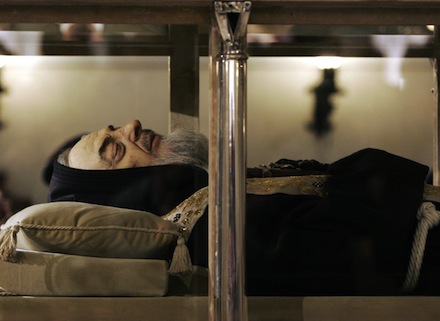Fifty years ago Italy’s most famous modern saint was being treated like a criminal
In 1964, Pope Paul VI lifted the unjust and severe restrictions on Padre Pio’s ministry
By Mary O'Regan on Thursday, 12 June 2014

The body of St Pio lies in the church of Santa Maria delle Grazie (AP)
Fifty years have passed since 1964, when Padre Pio was freed from certain tight constraints that bound him.
The humble Italian friar had been blessed with supernatural gifts such as reading souls, hearts and minds, and also phenomenal intercessory powers such as interceding for the sick so that they obtained miraculous cures from God. But in 1960 Padre Pio’s ministry was seriously limited following a strange series of events.
I find it dangerous for my stress levels to reflect on the way it was started by his fellow friars attempting to manipulate him. A very divisive issue was the money poured into the hospital, which Padre Pio had founded, the House for the Relief of Suffering.
Hundreds of thousands of pounds were donated for the construction of the hospital. Excited by the idea of making quick cash, Padre Pio’s superiors asked him if they could use the donations for a get-rich-quick scheme. Padre Pio refused because the money did not belong to him. When they lost huge sums on the scheme, they commanded him out of obedience to give them the donations for the hospital. To their chagrin, he refused again. This earned him their displeasure, and in order to seek evidence against him, they bugged his confessional – though Padre Pio cut the wiring with a pen knife.
A detailed report on Padre Pio’s alleged wrong-doing was put before Pope John XXIII. It included allegations that Padre Pio had sexualised contact with some women who went to him for Confession. Stefan Campanella’s book is a masterclass in understanding the events leading to the false information given to St John XXIII, and the consequences for Padre Pio.
An Apostolic Visitation was called for. The CDF, then known as the Holy Office, gave the role to Mgr Maccari. In the summer of 1960, the solemn Mgr Maccari visited Padre Pio, during the saint’s 50th anniversary of his ordination, and then drew up a list of sanctions. Fr Apostoli’s broadcast, Padre Pio: The Later Years, covers the topic of Mgr Maccari’s visitation well.
Padre Pio was prohibited from celebrating weddings and baptisms, he was only given a strict 30-minute slot for Mass, which was tight when you consider that Padre Pio spent four hours celebrating Mass on a feast day. Some individuals were barred from going to him for confession, and when he did hear Confessions, he only had three minutes for each penitent. He was not allowed to speak to women alone. In addition, monks at the monastery who were his friends were sent away, including some who acted in a nurse capacity to St Pio because he was so ill. Also, Padre Pio had to sign over the title of the House for the Relief of Suffering.
Most gallingly, Padre Pio’s superior, Fr Rosario, went further than the CDF. He put up embarrassing signs telling people not to approach Padre Pio, forbade the other friars from showing kindness to Padre Pio such as helping him up the stairs or bringing him a glass of beer in the extreme heat.
For a time it looked like Padre Pio would live out his remaining years being treated as a miscreant. For a wonderfully detailed account of this period of time in St Pio’s life, I recommend Renzo Allegri’s book, Padre Pio: Man of Hope.
But Paul VI changed things around rapidly. The Pope was not averse to St Pio. As Cardinal of Milan, Paul VI had sent a request for prayers to Padre Pio in 1959. In 1964, Pope Paul intervened with the CDF and ordered that Padre Pio be allowed to practise his ministry “in complete freedom” and that he was not to be confined “like a criminal”.
It is now 50 years since Padre Pio’s good name was restored in 1964. This is a cause for celebration in itself, but there is further reason for joy. The fact that it happened in 1964 means that Padre Pio had four whole years before his death in 1968 to practise his ministry and establish his reputation as a saint. For sake of argument, had the sanctions been lifted in 1967, then Padre Pio would have had very little time to freely demonstrate his saintliness, before dying in 1968.
No comments:
Post a Comment